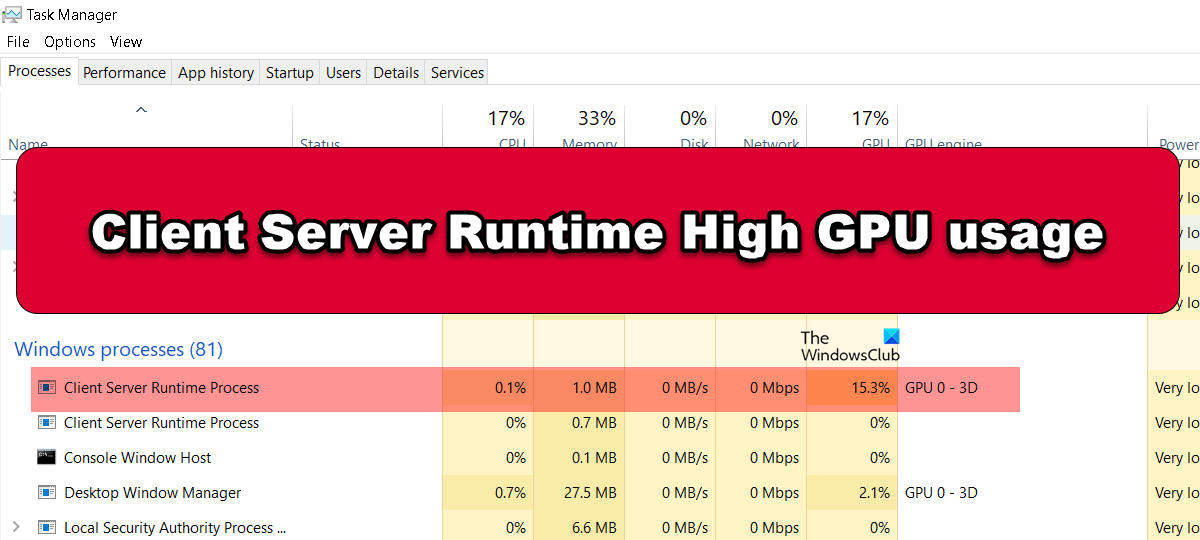What is Client Server Runtime?
Client Server Runtime or Csrss.exe is a genuine Windows process and has been an integral part of the OS since Windows NT 3.x days. It looks after the graphics of the operating systems, and manages and does other important things related to graphics. However, it doesn’t have too much of a role in the latest iteration of Windows, as most of its work is done by Windows Kernal after the release of Windows NT 4.0.
But the process is still present in all the versions of Windows and can be found at the following location. There is no possible way the Client Server Runtime should consume a lot of GPU, there is no need for it to do that. In case, you are noticing the server chugging your GPU resources, check out the solutions mentioned below.
Fix Client Server Runtime High GPU usage
If the Client Server Runtime (Csrss.exe) is causing high GPU usage on your Windows 11/10 computer, follow the solutions mentioned below to resolve the issue. Let us talk about them in detail.
1] Disable Hardware-accelerated GPU scheduling
The very first thing we need to do is disable the Hardware-accelerated GPU scheduling. The service is usually enabled in Settings and to take the load off the CPU, it allocates some high-priority tasks to the GPU. If you face a high GPU error, then you must disable the feature using the following steps. Hopefully, this will do the trick for you.
2] Make sure that the process running on your computer is not a virus
As mentioned earlier, Client Server Runtime error is a genuine Windows process. Having said that, there are a lot of viruses that can masquerade as a genuine process. To confirm that the process running on your system is not a virus, open Task Manager, right-click on the process, and select Properties. In case, the process is not currently running, go to the Details tab, look for the Client Server Runtime option, and select Properties. Now, you need to check the following two things.
Location: C:\Windows\System32Digital Signature: Microsoft Windows
In case, you conclude that the process is a virus, you can use Microsoft Defender Offline scan or a third-party antivirus. If you want to run the Windows Defender Offline scan, follow the prescribed steps. Regardless of the antivirus, you choose to use, cleaning up the antivirus will do the job for you.
3] Roll back your driver
A buggy update can cause serious issues for you, and there have been some as of late when talking about Graphics Drivers. If you still see high GPU usage, there is no harm in rolling back your driver. Follow the prescribed steps to do the same. In case, the Roll Back Driver button is greyed out, you won’t be able to roll back the driver, instead, go to the next solution and update it.
4] Update the Graphics Driver
If you are unable to rollback or if rollbacking didn’t work, we can update the driver in order to get rid of the bug. There are various ways to update a driver, you can pick any one of the mentioned below and get on with it.
Navigate to the official website of the Graphics driver manufacturer and download the latest version of the driver.Install Driver and Optional updates from Windows Settings.Update the Graphics drivers from Device Manager.
Hopefully, this will do the trick for you.
5] Do not overclock
In case you are overclocking your GPU in order to get a bit more performance out of it, be ready to experience all sorts of issues. There are a lot of games incompatible and won’t launch if you have overclocked your CPU or GPU, also, you will experience high GPU usage from services that normally would use a small fraction of your resources. Long story short, if you have overclocked, go ahead and disable it.
We hope that you are able to resolve the issue using the solutions mentioned in this post. Read: Desktop Window Manager dwm.exe High Memory, CPU, GPU
How do I stop client server runtime process from using GPU?
Client Server Runtime is related to your computer’s graphics, so, it is pretty normal for it to use some part of your GPU. However, in modern OSs, Client Server Runtime uses a very small portion of the GPU as most of its work is redirected to Windows Kernal. So, if the Client Server Runtime is showing high GPU usage, check out the solutions mentioned in this post to resolve the issue or stop Client Server Runtime process from using your GPU.
Can I end client server runtime process?
No, you can not close the Client Server Runtime. You can try doing the same, right-click on the process in the Task Manager and select End Task. You will be greeted with an error message stating that doing so will make your system unstable. If you decide to proceed, the next error message will say Access Denied. Also read: Fix .NET Runtime Optimization Service High CPU usage on Windows.

